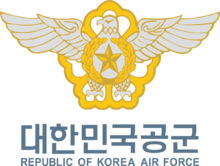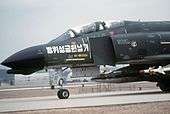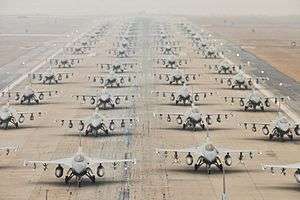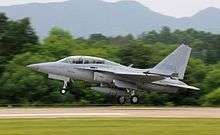Republic of Korea Air Force
| Republic of Korea Air Force 대한민국 공군 | |
|---|---|
 Republic of Korea Air Force emblem[1] | |
| Founded | October 1, 1949 |
| Country |
|
| Type | Air force |
| Size |
65,000 (2014)[2] 794 aircraft[3] |
| Part of |
|
| Garrison/HQ | Gyeryong, South Korea |
| Nickname(s) | "ROK Air Force", "ROKAF", "South Korean air force", "SKAF" |
| March | "Air Force Anthem" (Korean: 공군가; Hanja: 空軍歌; Gonggunga, literally "air force song")[4][5] |
| Mascot(s) | Haneuli and Purumae |
| Engagements |
Korean War Vietnam War Persian Gulf War Global War on Terrorism |
| Commanders | |
| Air Force Chief of Staff | General Jeong Kyung-Doo (since 2015) |
| Notable commanders | Chang Sung-hwan (1962–1964) |
| Insignia | |
| Roundel |
|
| Low-visibility roundel |
|
| Logo |
 |
| Flag |
 |
| Former roundel |
|
The Republic of Korea Air Force (ROKAF; Korean: 대한민국 공군; Hanja: 大韓民國 空軍; Romanization: Daehanminguk Gong-gun), also known as the ROK Air Force, is the aerial warfare service branch of South Korea, operating under the Republic of Korea Ministry of National Defense.
History


Early years
Shortly after the end of World War II, the South Korean Air Construction Association was founded on August 10, 1946 to publicize the importance of air power. Despite the then-scanty status of Korean armed forces, the first air unit was formed on May 5, 1948 under the direction of Dong Wi-bu, the forerunner to the modern South Korean Ministry of National Defence. On September 13, 1949, the United States contributed 10 L-4 Grasshopper observation aircraft to the South Korean air unit. An Army Air Academy was founded on January, 1949, and the ROKAF was officially founded on October 1949.
Korean War
The 1950s were a critical time for the ROKAF as it expanded tremendously during the Korean War. At the outbreak of the war, the ROKAF consisted of 1,800 personnel but was equipped with only 20 trainer and liaison aircraft, including 10 North American T-6 Texan advanced trainers purchased from Canada. The North Korean air force had acquired a considerable number of Yak-9 and La-7 fighters from the Soviet Union, dwarfing the ROKAF in terms of size and strength. However, during the course of the war, the ROKAF acquired 110 aircraft: 79 fighter-bombers, three fighter squadrons, and one fighter wing. The first combat aircraft received were North American F-51D Mustangs, along with a contingent of US Air Force instructor pilots under the command of Major Dean Hess, as part of Bout One Project. The ROKAF participated in bombing operations and flew independent sorties. After the war, the ROKAF Headquarters was moved to Daebangdong, Seoul. Air Force University was also founded in 1956.
1960s
To counter the threat of possible North Korean aggression, the ROKAF underwent a substantial capability enhancement. The ROKAF acquired North American T-28 Trojan trainers, North American F-86D Sabre night- and all-weather interceptors, Northrop F-5 fighters and McDonnell Douglas F-4D Phantom fighter bombers. Air Force Operations Command was established in 1961 to secure efficient command and control facilities. Air Force Logistics Command was established in 1966, and emergency runways were constructed for emergency use during wartime. The Eunma Unit was founded in 1966 to operate Curtiss C-46 Commando transport aircraft used to support Republic of Korea Army and Republic of Korea Marine Corps units serving in South Vietnam during the Vietnam War.[7]
1970s
The ROKAF was posed with a security risk, with an increasingly belligerent North Korea throughout the 1970s. The South Korean government increased its expenditure on the ROKAF, resulting in purchase of Northrop F-5E Tiger II fighters in August 1974 and F-4E fighter bombers. Support aircraft, such as Fairchild C-123 Providers and Grumman S-2 Trackers were also purchased at the time. Great emphasis was placed in the flight training program; new trainer aircraft (Cessna T-41 Mescalero and Cessna T-37) were purchased, and the Air Force Education & Training Command was also founded in 1973 to consolidate and enhance the quality of personnel training.
1980s
The ROKAF concentrated on qualitative expansion of aircraft to catch up to the strength of North Korean Air Force. In 1982, Korean variants of the F-5E, the Jegong-ho were first produced. The ROKAF gathered a good deal of information on the North Korean Air Force when Captain Lee Woong-pyeong, a North Korean pilot, defected to South Korea. The Korean Combat Operations Information center was soon formed and the Air Defence System was automated to attain air superiority against North Korea. When the 1988 Seoul Olympics was held in South Korea, the ROKAF contributed to the success of this event by helping to oversee the entire security system. The ROKAF also moved its headquarters and the Air Force Education & Training Command to other locations. Forty General Dynamics F-16 Fighting Falcon fighters were purchased in 1989.
1990s
South Korea committed its support for coalition forces during the Persian Gulf War, forming the "Bima Unit" to fight in the war. The ROKAF also provided airlift support for peacekeeping operations in Somalia in 1993. The increased participation in international operations depicted the ROKAF's elevated international position. Over 180 KF-16 fighters of F-16 Block 52 specifications were introduced as part of the Peace Bridge II & III program from 1994. In 1997, for the first time in Korean aviation history, female cadets were accepted into the Korean Air Force Academy.
2000s
The last of the old South Korean 60 F-5A/B fighters were all retired in August 2007, and they were replaced with the F-15K and F/A-50. On October 20, 2009, Bruce S. Lemkin, deputy undersecretary of the U.S. Air Force said that the ROKAF's limited intelligence, surveillance and reconnaissance (ISR) capabilities increased the risk of instability on the Korean Peninsula and suggested the purchase of American systems such as the F-35 Lightning II to close this gap.[8]
2010s
The South Korean Air Force also expressed interests in acquiring the RQ-4 Global Hawk remotely piloted vehicle (RPV) and a number of Joint Direct Attack Munition conversion kits to further improve its intelligence and offensive capabilities.
Order of battle
.jpg)

.jpg)
.jpg)
- Republic of Korea Air Force Headquarters
- Air Force Operations Command
- 5th Tactical Airlift Wing, based at Gimhae
- 251st Tactical Air Support Squadron flying C-130H and C-130H-30
- 256th Tactical Air Support Squadron flying CN235-100M
- 258th Tactical Support Squadron flying CN235-100M and CN235-220M
- 259th Tactical Air Support Squadron flying UH-60P
- 15th Composite Wing, based at Seongnam
- 255th Special Operations Squadron flying C-130H
- 257th Tactical Air Transport Squadron flying C-130H
- 35th Combined Group
- 296th Special Transport Squadron flying the HS-748, CN235-220M, Boeing 737-300, Sikorsky VH-60P and a Sikorsky S-92
- 6th Combat Control Team/Combat Search And Rescue Group
- 5th Tactical Airlift Wing, based at Gimhae
- Air Force Northern Combat Command
- 8th Fighter Wing, based at Wonju
- 10th Fighter Wing, based at Suwon Air Base
- 101st Fighter Squadron flying KF-5E/KF-5F/F-5F
- 201st Fighter Squadron flying KF-5E/KF-5F/F-5F
- 39th Tactical Reconnaissance Group
- 131st Tactical Reconnaissance Squadron flying 17 RF-4C Phantom
- 17th Fighter Wing, based at Cheongju
- 152nd Fighter Squadron flying F-4E
- 153rd Fighter Squadron flying F-4E
- 156th Fighter Squadron flying F-4E
- 29th Tactical Development & Training Group
- 191st Tactical Development & Training Squadron flying F-16C/D and KF-16C/D
- 192nd Tactical Development & Training Squadron flying F-5E/F and KF-5E/F
- 6th Search & Rescue Group
- 233rd Combat Search & Rescue Squadron flying Bell 412, Eurocopter AS532L/L2 Cougar and Sikorsky HH-60P helicopters
- 235th Combat Search & Rescue Squadron flying Kamov HH-32 (KA-32T) and Boeing Vertol HH-47D Chinook helicopters
- 18th Fighter Wing, based at Gangneung
- 105th Fighter Squadron flying F-5E/F-5F/KF-5F
- 112th Fighter Squadron flying F-5E/F-5F/KF-5F
- 205th Training Squadron flying F-5E/F-5F/KF-5F
- 19th Fighter Wing, based at Jungwon Air Base
- 161st Fighter Squadron flying F-16C/D (Block32)
- 162nd Fighter Squadron flying F-16C/D (Block32)
- 155th Fighter Squadron flying KF-16C/D (Block52)
- 159th Fighter Squadron flying KF-16C/D (Block52)
- 20th Fighter Wing, based at Seosan Air Base
- 120th Fighter Squadron flying KF-16C/D (Block52)
- 121st Fighter Squadron flying KF-16C/D (Block52)
- 123rd Fighter Squadron flying KF-16C/D (Block52)
- 157th Fighter Squadron flying KF-16C/D (Block52)
- Air Force Southern Combat Command
- 1st Fighter Wing, based at Gwangju
- 11th Fighter Wing, based at Daegu
- 102nd Fighter Squadron flying F-15K
- 122nd Fighter Squadron flying F-15K
- 110th Fighter Squadron flying F-15K
- 16th Fighter Wing, based at Yecheon
- 202nd Fighter Squadron flying F-5E/F-5F/KF-5F
- 216th Flying Training Squadron flying 16 T-59 (BAe Hawk Mk.67)
- 38th Fighter Group, based at Gunsan
- 111th Fighter Squadron flying KF-16
- Air Defence Artillery Command
- 1st Air Defence Artillery Brigade
- 2nd Air Defence Artillery Brigade
- 3rd Air Defence Artillery Brigade
- Air Defense & Control Command, based at Osan
- Air Force Logistics Command
- Maintenance Depots
- Supply Depots
- Transportation Groups
- Air Force Education & Training Command
- Basic Military Training Wing
- 3rd Flying Training Wing
- Air Force Aviation Science High School
- Technical Schools
- Aerospace Projects Group
- Aerial Combat Development Group
- Air Force Academy
- Air Force Operations Command
Current projects
.jpg)
F-X fighter program
- F-X Phase 1
The first phase of the air forces fighter procurement programs was the addition to the ROKAF of the F-15K Slam Eagle to fulfill the requirements of the "F-X" next generation fighter program in 2002.
- F-X Phase 2
For the second phase of the F-X program, ROKAF has purchased 21 additional F-15K to compensate for the retirement of their F-5A/B in August 2007.
- F-X Phase 3
The third phase of the F-X project is a bid for an advanced multi-role strike fighter aircraft by 2014, intended to replace the aging F-4 Phantom II and F-5. The F-35A Lightning II was selected in November 2013 following the cancellation of the previous competitive tender, with 40 Block 3F aircraft to be acquired beginning in 2018. 20 additional unspecified fighter will also be purchased.[9] The contract became formal on September 2014.[10]
E-X Early warning aircraft program
The E-X Airborne Early Warning (AEW) aircraft program (also known as 'Peace Eye') was undertaken by the Republic of Korea Air Force to purchase AEW capability to strengthen ROKAF's ability to detect and distinguish between friendly and hostile aircraft. The two candidates for this program were the Boeing 737 AEW&C and a consortium of Israel Aerospace Industries, Elta, L-3 Communications and Gulfstream Aerospace offering a Gulfstream G500/G550 aircraft equipped with Phalcon radar.
Originally, the ROKAF preferred the Gulfstream as it was cheaper than the Boeing counterpart. The Gulfstream was, in turn, less capable than the Boeing. However, the fact that almost no other nations, barring Japan, has advanced AWACS gave the Koreans the impression that the Gulfstream would be adequate enough to handle the given task of the E-X project.
The United States issued a warning to the IAI/Elta consortium that several of the AWACS technologies employed aboard the Gulfstream were developed by the United States, such as the IFF system, TADIL A/B (Link 11) and J (Link 16), satellite communications and AN/ARC-164 Have Quick II radios, and thus that Israel was obliged not to resell any of these technologies to another country without the permission of the United States.
In August 2006 DAPA announced that the Gulfstream was disqualified from the competition because of the failure to obtain US export licences for the datalinks and satellite communications, leaving the Boeing as the only proposal.[11] In November 2006, the Boeing 737 AEW&C was announced to be the winner of the E-X AEW aircraft competition. In 2011, the first two of four Peace Eye aircraft were delivered. The final two aircraft were delivered in 2012.
KF-X future fighter program
The KF-X program is an early-stage project to develop an indigenous fighter aircraft. The current proposal is to develop an F-16 Block 50 class aircraft with basic stealth capabilities to replace the F-4D/E Phantom II and F-5E/F Tiger II aircraft. South Korea is reportedly seeking technological assistance from Saab, Boeing and Lockheed Martin for the production of the KF-X. On 15 July 2010, the Indonesia government agreed to fund 20% of KF-X project cost in return of around 50 planes built for Indonesian Air Force after project completion. In September 2010, Indonesia sent a team of legal and aviation experts to South Korea to discuss copyright issues of the aircraft. In December 2010 the program shifted from a F-16 class fighter to a stealth aircraft in order to respond to North Korean pressure.
The KF-X is envisioned as a medium fighter to at first supplement, then replace the ROK Air Force's KF-16 fleet. It will have capabilities in between the light FA-50 fighter and the high-grade, long range, heavy payload F-15K and F-35 Lightning II.[12]
Mid-altitude unmanned aerial vehicles (MUAV)
South Korea will resume a once-aborted program to develop mid-altitude unmanned aerial vehicles (MUAV) to bolster its monitoring capabilities of North Korea’s missile and nuclear programs. The state-funded Agency for Defense Development launched the indigenous drone development project in 2006 and made a prototype in May 2010. The medium-altitude, long-endurance UAV is designed to fly at an altitude of up to 10 kilometers and its radar can scan as far as 100 km. Korea hopes to complete development of the combat drones by 2018.[13] The overall performance of the drones under development in Korea is believed to be similar to the MQ-9 Reaper.
HALE (High Altitude, Long Endurance) UAV
Seoul had shown interest in the high-altitude, long-endurance Global Hawk drone to conduct intelligence missions on North Korea, as it is preparing to take over wartime operational control from Washington at the end of 2015. But the price was nearly a three-fold jump from the initial price estimated by the defense ministry, and much higher than $875 million offered by the U.S. government in July 2011.[14] The U.S. Congress approved the sale to South Korea for 4 Global Hawk UAVs, but Seoul could have reconsidered the deal because of the high costs.[15] Northrop Grumman was awarded the contract to provide South Korea with four Block 30 Global Hawks in December 2014, with all to be delivered by June 2019.[16]
Aerial tanker
The Air Force is to acquire four aerial refueling tankers between 2017-2019. Potential candidates include the Airbus A330 MRTT and the Boeing KC-46. The tankers will be used to refuel combat jet fighters. Previous attempts to buy tankers had been delayed due to budget constraints.[17] On 12 August 2013, DAPA approved the plan for tanker acquisition. Bidding was to begin in February 2014, with the winner to be announced in October 2014 after evaluations of price and performance. Air-to-air refueling will increase the endurance of the KF-16 by 70 minutes, and the F-15K by 90 minutes. DAPA declined to reveal the budget for the plan and estimated to be over $1.3 billion.[18] A plan to buy four aircraft was to be approved in November 2013, with evaluations to proceed from March to May 2014. The contract is valued at $940 million.[19] Along with the Airbus A330 MRTT and Boeing KC-46, Israel Aerospace Industries is offering a version of the Boeing 767-300ER-derived multimission tanker transport.[20]
Aircraft
Current inventory


_RoK_(3097668829).jpg)
Retired aircraft
Previous aircraft operated by the Air Force consisted of the P-51 Mustang, North American F-86 Sabre, F-4 Phantom II, Curtiss C-46, Douglas C-47, Lockheed T-33, North American T-28, North American T-6, Sikorsky H-19, and the Bell UH-1 Huey.[32][33][34]
Air-defense weapons
- The ROKAF Air Defence Artillery Command transferred from the Republic of Korea Army's air defense artillery and was established as a basic branch on 1 July 1991.[35] Following the establishment of the ROKAF Air Defence Artillery Command as a separate service in 1991, the army began to develop further its own air defense artillery assets (short range SAM, SPAAG and man-portable air-defense systems) in support of ground operations.

| Name | Origin | Type | Variant | In service | Notes | |
|---|---|---|---|---|---|---|
| SAM | ||||||
| MIM-104 Patriot | United States | ABM / SAM system | PAC-2 GEM/T | 8 batteries | 8 batteries to be upgraded to PAC-3 standard[36] | |
| MIM-23 Hawk | United States | SAM system | I-Hawk | 24[36] | ||
| Doosan K-SAM Chunma | Republic of Korea | short range SAM system | 100 | tracked vehicle | ||
| KM- SAM | Republic of Korea | 0 | tracked vehicle | |||
| Anti-aircraft artillery | ||||||
| K200 KIFV | Republic of Korea | mobile anti-aircraft gun | K263A1 | 200 | contains a self-propelled 20mm anti-aircraft gun | |
| K30 Biho | Republic of Korea | mobile anti-aircraft gun | 176 | contains twin 30mm self-propelled guns | ||
| MANPADS | ||||||
| KP-SAM | Republic of Korea | portable air defense | 2,000 | |||
Military ranks
Officer ranks can be learned fairly easily if one sees the pattern. "So" equals small; "Jung" equals medium; "Dae" equals large. "Jun" equals the prefix sub-.. Each of these is coupled with "wi" equals company grade, "ryeong" equals field grade, and "jang" equals general. This system is due to the hanja or Sino-Korean origin of the names.
Commissioned officers
| ROK Air Force rank | ROK Air Force insignia |
| Dae-jang
(General) |
|
| Jung-jang
(Lieutenant General) |
|
| So-jang
(Major General) |
|
| Jun-jang
(Brigadier General) |
|
| Dae-ryeong
(Colonel) |
|
| Jung-ryeong
(Lieutenant Colonel) |
|
| So-ryeong
(Major) |
|
| Dae-wi
(Captain) |
|
| Jung-wi
(First Lieutenant) |
|
| So-wi
(Second Lieutenant) |
Warrant officers
| ROK Air Force rank | ROK Air Force insignia |
| Jun-wi
(Warrant Officer) |
² |
Non-commissioned officers
| ROK Air Force rank | ROK Air Force insignia |
| Seonimwonsa
(Command Chief Master Sergeant) |
|
| Won-sa
(Chief Master Sergeant) |
|
| Sang-sa
(Senior Master Sergeant) |
|
| Jung-sa
(Master Sergeant) |
|
| Ha-sa
(Technical Sergeant) |
Enlisted
| ROK Air Force rank | ROK Air Force insignia | |
| Byeong-jang
(Staff Sergeant) |
||
| Sang-byeong
(Senior Airman) |
||
| Il-byeong
(Airman First Class) |
||
| I-byeong
(Airman) |
||
| Shinbyeong
(Airman Basic) |
¹: No one has held the rank of Won-su in the history of the ROK Armed Forces yet.
²: The Jun-wi (Warrant Officer)'s insignia is in brass color while the ones of Second Lieutenant and higher are in silver color.
See also
References
- ↑ "ROKAF Mark". www.airforce.mil.kr. Retrieved 3 August 2014.
- ↑ "국방백서 2014" (PDF). December 2014.
- ↑ Flightglobal - World Air Forces 2015 (PDF), Flightglobal.com
- ↑ "공군가" (in Korean). Retrieved September 2, 2016.
- ↑ https://www.youtube.com/watch?v=UxuMfgkm1Jg
- ↑ "경남도, 국산비행기 1호 '부활호' 복원". news.naver.com. Retrieved 2013-05-14.
- ↑ "Vietnam Studies: Allied Participation in Vietnam, Chapter VI: The Republic of Korea." page 131.
- ↑ Korea Urged to Secure Intelligence, Surveillance and Reconnaissance Systems
- ↑ South Korea to obtain 40 F-35As - Flightglobal.com, 22 November 2013
- ↑ "South Korea's biggest-ever weapons buy: $7B for 40 F-35A jets".
- ↑ Brendan Sobie (3 August 2006). "South Korea selects Boeing 737-based AEW&C system over Gulfstream G550 platform". Flightglobal.com. Retrieved 28 January 2011.
- ↑ Seoul Plans Phased-Development, Typhoon-Size Fighter - Aviationweek.com, 29 April 2013
- ↑ Korea to begin development of mid-altitude UAV” - english.yonhapnews.co.kr, June 14, 2013
- ↑ "U.S. Congress approves sale of four spy drones to S. Korea". arirang.co.kr. 3 May 2013. Retrieved 14 June 2013.
- ↑ "Korea rejected the U.S. Global Hawk UAV ?". news.dbv.vn. Retrieved 14 June 2013.
- ↑ Seoul finalises $657 million Global Hawk purchase - Flightglobal.com, 17 December 2014
- ↑ Air Force to acquire 4 aerial refueling tankers by 2019 - Globalpost.com, 6 August 2013
- ↑ S. Korea To Extend Range of Jets With Aerial Tankers - Defensenews.com, 12 August 2013
- ↑ South Korea To Open Bid for Aerial Tankers - Defensenews.com, 18 October 2013
- ↑ IAI offers 767 conversion for South Korean tanker contest - Flightglobal.com, 30 June 2014
- 1 2 3 "World Air Forces 2016". Flightglobal. Flightglobal International. 3 December 2015. Retrieved 11 December 2015.
- ↑ https://www.flightglobal.com/news/articles/adex-lockheed-sees-kf-16-upgrade-deal-as-imminent-418061/
- ↑ https://www.flightglobal.com/news/articles/adex-lockheed-sees-kf-16-upgrade-deal-as-imminent-418061/
- ↑ "South Korea ready to sign F-35 deal". flightglobal.com. Retrieved 28 September 2015.
- ↑ http://www.newsis.com/ar_detail/view.html?ar_id=NISX20150630_0013761645&cID=10301&pID=10300
- ↑ "ROK Air Force". globalsecurity.org. Retrieved 18 September 2015.
- ↑ "WAF 2004 pg. 86". Flightglobal Insight. 2004. Retrieved 4 October 2015.
- ↑ "Sikorsky Delivers Three S-92 Helicopters to Korean Air Force". aero-news.net. Retrieved 4 October 2015.
- ↑ "Korea air force academy to obtain 23 KAI KC-100s". flightglobal.com. Retrieved 18 September 2015.
- ↑ "World Air Forces 2015 pg. 28". Flightglobal Insight. 2015. Retrieved 4 October 2015.
- ↑ "Seoul finalises $657 million Global Hawk purchase". flightglobal.com. Retrieved 5 October 2015.
- ↑ "World Air Forces 1955 pg. 648". flightglobal.com. Retrieved 5 October 2015.
- ↑ "World Air Forces 1973 pg. 152". flightglobal.com. Retrieved 5 October 2015.
- ↑ "World Air Forces 1969 pg. 249". flightglobal.com. Retrieved 5 October 2015.
- ↑ http://www.law.go.kr/lsInfoP.do?lsiSeq=10329#0000
- 1 2 Trade Registers. Armstrade.sipri.org. Retrieved on 6 October 2015
External links
- ROK Air Force official website (Korean / English)
- Korea Aerospace Industries(KAI) official website (Korean / English)
- Foxmouse Airbase (Korean)
- ROKAF (Republic of Korean Korea Air Force)